 |
Space Precinct
- Behind
The Scenes with SFX Director Steven Begg
By David Sisson ............................................... |
 |
Space Precinct
- Behind
The Scenes with SFX Director Steven Begg
By David Sisson ............................................... |
| Steven Begg has been in the film industry for nearly 30 years, working on television shows, commercials and major feature films; with a list of credits including 'Aliens', 'Lost In Space', 'Tomb Raider', 'Batman' and 'Casino Royale'. I caught up with him in 2011 to chat about his work on Gerry Anderson's 'Space Precinct', the 1990s cops-and-aliens-in-space television show. |
| David:
I guess if we are going to talk about ‘Space
Precinct’ then we should really mention ‘Space
Police’, which was a one-off hour long pilot
film made back in 1986, for a reported one million
pounds. Steven: ‘Space Police’ was an idea concocted by Tony Barwick and Gerry. They were taken by the show ‘Hill Street Blues’, which was very big at the time, and Tony came up with this hybrid idea of putting that concept in space, which he and Gerry embellished on. Meanwhile, I had been working on ‘Aliens’ with Bob and Dennis Skotak, the VFX Supervisors, and I started to get aggravation from the ACTT union that I didn’t have a union ticket (which I did) and interference in my work on that film which escalated to a point that I thought I’ve just got to get off this. So I ultimately moved onto ‘Space Police’, which I’m not sure was such a good move with hindsight. It was still a very low-budget production (not a million pounds for sure and most of the set pieces came from ‘Aliens’) so everything was shot on 16mm. But I wanted to expand on the multi-exposure trick first used on ‘Space 1999’, and then by myself on ‘Terrahawks’, by double exposing nebula’s and interesting space vista’s with matte painted planets into the space shots. I also learned a lot working with Bob and Denny on ‘Aliens’ as well and exported a lot of in-camera tricks we used on ‘Aliens’ into ‘Space Police’. Such as using a 50-50 Ghost-glass mirror to put two images together for example. David: Again
you used stop-motion, this time on a couple of characters
as well as the flying police car. David: The
explosions in the show looked spectacular – the
monorail train exploding as it fell down the cliff was
superb. David: What
did you think to the finished film, did you expect the
pilot to lead into a series at the time? |
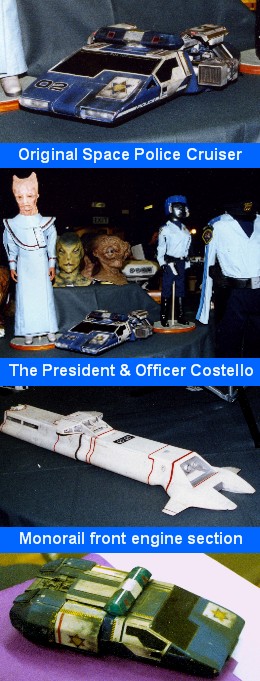 |
| To be honest I don’t think a
lot of the Visual effects were actually that great, other
than some of the opening VFX shots. David: Was
it a surprise to you when Gerry returned to selling the
concept in 1994? I assume you were involved with the
small concept film that was produced to help sell the
idea at a trade show in America. I believe that parts
were reused from ‘Space Police’ and you
designed the prototype police cruiser at this early
stage. David: Did
you have any input into the format of the new series?
|
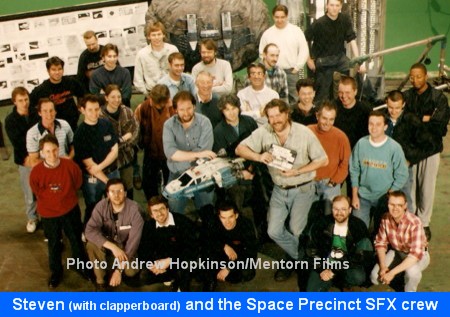 |
 |
 |
David: Your
original flying car design was much more sci-fi than the
finished article. Steven: It was felt that my original streamlined version didn’t look too police-car-like, so Bill Pearson and his guys modified it to look more angular. It was a cross between a police helicopter and the Space Shuttle and it would leave the planets atmosphere in a huge blast of engine plasma (poorly realised by Magic Cameras then proto Digital Dept) - this never got passed on to the shows writers. I saw the Police Car as the star of the show and the only one that could escape and re-enter the planets atmosphere, thus giving them a lead on the planet-based villains they would deal with each week (Why the hell are Brogan and co in space anyway?). David: Did
you design the other craft in the show – like the
Suburb and Precinct Station House? David: How
did you approach each script – were there regular
script read-throughs with all department heads and
discussions with the director? David:
Did you draw any of the storyboards to your effects this
time, or were you given any from the Directors? David:
Were you ever involved with the budget – or get
feedback on how much you had to spend, or warned of any
over spend? David: What
sort of set up did you have in your department? How many
staff? David: How
was the SFX department organised. Were there people who
specialised in doing the ‘space shots’ or
‘flying wire-work’ - or did everyone work in
all areas? David: What
sort of cameras did you have to use for your effects? David: What
is Super-16? If my memory serves it is wider than normal
16mm film but looses some sprockets? If so doesn’t
that pose a problem for film stability? David: There
were some in-camera space shots but you tended to use
motion-control most of the time – it looked very
good, was that all 35mm? David: You
had had a lot of success (with space scenes) by just
using multiple exposures in ‘Terrahawks’,
did you consider that technique again before opting for
motion-control, or did you want to establish a different
look for the new series? David: Were
some of the Suburb and Precinct House shots done
in-camera? There is an often used downward angle shot of
the Precinct House where it swings across screen with the
planet below and bright sun glare from the right –
it looked very clean and natural. David: The
space effects work certainly looked impressive. David: How
were the colourful star-backgrounds created – they
seemed to be very nice paintings? David: Bill
Pearson got a screen credit at the start of each episode
– I’ve not seen a modelmaker get such a
prominent credit before. You must have worked very
closely with him. David: Trying to create a busy futuristic city must have been a nightmare for you, it’s not like a single spaceship against plain black space, you really have to fill the screen with detail. |
| Steven: I recon
the big futuristic city was probably the most difficult
SFX in any of Gerry’s shows and I don’t think
we pulled it off completely. We also started shooting
without all the requested miniatures built, i.e. no city!
The modelmakers just couldn’t get into doing the buildings quick enough (too boring) so I had to go raiding other productions to flesh out our city in the initial episodes. Some of the buildings came from ‘Little Shop of Horrors’ and a sci-fi film my chum Angus Bickerton was doing at the time for example. We had ‘Blade Runner’ as the visual model but it was seriously hampered by our really awful live-action production design, were the buildings and alleyways had red brick and breeze block finishes at ground level and we had to transpose that into supposedly mega alien structures which was never going to work, and didn’t. It was also mostly daylight in our SFX shots which didn’t help the atmosphere either. Our digital dept also got lumbered with doing multiple screen inlays (monitors, viewscreens) rather that concentrating on the money shots where we wanted to see people in our model streets. |
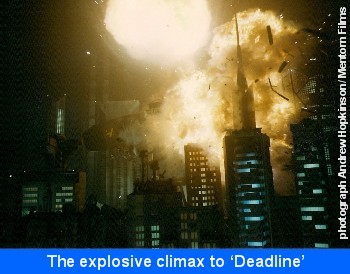 |
 |
David: How
were the long distance shots of the city done –
looking down through the clouds. Was that a Glass-shot of
some sort? Steven: It always looked to me that the high altitude shots of the Earth made its clouds look like Talcum powder on a flat layer just above the surface of the planet. So using that guide I got a big bit of glass, 8ft by 8ft and supported by 6inch blocks on its corners, positioned it over a matte-painting or ultra-small miniature of the planet or city surface. I then sprinkled Talc onto the glass surface till I thought it looked good. The great thing is that you get a shadow from the Talcum clouds on the model/painting surface if its a day shot and they are back-lit and glowing if its night. For the really high shots, i.e. space shots, we projected a cloud transparency then a city lights image (which was a bit of chalk artwork on black) onto a white dome to represent our planet, Altor. This technique was started on ‘2001’ and then used on ‘1999’; the difference with us was that we had motion-control to put nice roles and drifts on our shots. David: The
city seemed to light up so not just painting? Also later
shots introduced clouds moving past camera – double
exposed in? David: You
seemed to try and put movement into the camera during
most of the model sequences– instead of a locked-off
shot there seemed to be pans and twists. Was this to help
disguise the wirework, or make the scene more dynamic? David: You
certainly seem to use plenty of smoke and lights to make
the cityscapes look believable – there were even a
few lasers shining in the sets. David: Did
you shoot all the city miniatures in smoke? Did everyone
have to wear masks? David:
Talking of ‘Blade Runner’, there was a
nod to that film in the episode ‘Deadline’ with
a dirigible floating over the city showing advertisements
– how were the adverts placed on the models screen? David: How
many police car models did you have for filming, were
there two or more of the big models? And did the flashing
police lights cause problems for the different filming
speeds you were using? David: In
the episode ‘Flash’ one of the police cars
exploded, was this a complete dummy model, was it made of
special material to break up? David: I
did like the numerous flying chase sequences; they really
began to get very exciting. I passionately hate wirework because no matter what, you are always controlled by simple physics. Things on wires will only do so much so quickly! One trick you use is to slightly over-crank the camera 36, 48-72fps to try to hide the wobbles and shakes but the editors cut the show on a computerised editing system called Lightworks where at the push of a button you could speed shots up, therefore counter-acting the slow-motion smoothing on the models! I had a constant battle with them over that but a few shots got through. Derek and Brian never had to do similar work so I couldn’t even learn from them. So I got the guys to put the buildings on tracks and the camera on tracks, and then move them all in order to apparently speed up our car chases. It was the equivalent of a three-dimensional roller backing!! David: How
were the vehicle crash scenes shot? Were the models
pulled through the scenes on a wire or thrown across via
an air-cannon or catapult arrangement? David:
If I were to criticize I would say that the city
didn’t really have much in the way of other flying
vehicles around – really there should have been
hundreds of flying cars on screen. Obviously budget and
time were against you but were any attempts/or test shots
done to add more vehicles into the scenes? David:
Did you have any involvement with the
live-action set? David:
Did you have any effects ideas for the show that
never made it to the screen? David:
So paper was used for the live-action, how was
miniature snow done? |
| David: In
the episode ‘Body And Soul’ Brogan and his son
fly their Hopper over Merlin’s Asteroid and are
surprised to see a crashed spaceship – but I was
more surprised by them flying over some strange alien
looking buildings on the surface, especially as they
weren’t even mentioned in the script? Steven: The unusual artifacts on the asteroid were an idea that had hung over from the original plot idea of Brogan and son visiting a comet, and then discovering in its tale some derelict spaceships – just like the film ‘Lifeforce’. With hindsight it was a bad idea (of mine) to keep the alien objects on the asteroid, as it was confusing to the viewer. |
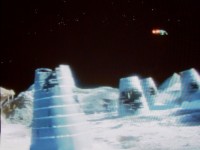 |
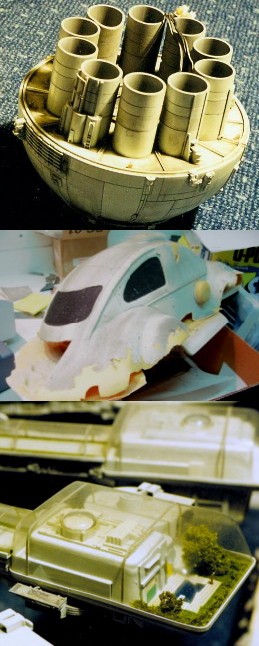 |
David: As
the series progressed and the first episodes were
completed were you happy with the results? Steven: I thought we got off to a shaky start (Such as the Pizza bike chase where I discovered the editors were speeding up shots for the first time.) but things did improve - but ultimately I was still bitterly disappointed with the show. All the publicity guff about ‘the biggest budget ever’ severely damaged the show big-time! Also why were we shooting on super 16mm 16.9 only to have it cheaply cropped to normal 4.3 - god only knows…. We also had a one light telecine which was originally just for rushes, but then became the master for the show (it’s much much cheaper) and just looked flat and grainy. I also thought we had the crummiest looking live-action sets ever committed to a sci-fi show, which looked like they came from Coronation Street! David:
You sound a little down on the show. David:
Looking back now what are your views on the
show, do you have a favourite episode at all? David: Thank you very much for your time Steven. |
Photographs by
Dave Watkin and David Sisson.
Thanks also to Andrew
Hopkinson for additional behind-the-scenes photographs (as
marked).
'Space Precinct' is copyright by Mentorn Films
No infringement of
copyright is intended - non-profit fan interest site only.
Saving the Space Suburb |
| Many years ago (late 1990s) I got a phonecall asking
me if I wanted to go and ‘save’ some Space
Precinct film props that were stored in a warehouse
in Wales, a warehouse that was shortly due to be
demolished. I agreed and was soon being driven down to
the place in a rather slow and noisy van. As we entered Wales it began to rain, and then continued to rain very heavily for the rest of the day, which certainly made the trip much harder especially when you don’t know quite where you’re going, and then have to meet up with another group, and then hopefully find the chap who had the keys and was going to let us into the place. |
| Hours later we all stood together, in the rain, in a
rather depressing run-down industrial area, we were
finally let through the padlocked gates and entered the
building – only to still find ourselves standing in
rain as parts of the roof had gone and the water was
dripping through the ceiling! Walking through dark
corridors illuminated by the occasional working light
bulb, we quickly discovered that there wasn’t much
left - as we were told that local school children had
been entering the building to steal everything –
great! Room after room was empty but for broken boxes and bits of scrap, at one point I tripped over a casting of a ‘Space Hopper’ which I put in a bag. This appears to be a simple casting used for the crash sequence in ‘The Fire Within’. There was a shattered top hull casting and a rough casting of the bottom – the rubber mould for which was lying in a mud puddle outside in the yard. After searching all the rooms we found just one, very big, box which we pried open to discover lots of polystyrene packing chips and the big Space Suburb model buried beneath. This model had not been taken purely because of its size, which as I say was large. Leaving it in the box the group of us managed to manuvere this almost back-breaking weight out of the room, up some stairs and out to the van – where we quickly gave up all hope of staying even remotely dry as we struggled through the large puddles, mud, and torrential rain to lift this box into the back of the vehicle. With one thing saved we were then lead round the back to a very old and rusty looking Nissen hut, inside rested the full-sized Police Cruiser and the Hopper – both very large and broken. Against one corner stood a pile of fibreglass moulds of the alien masks, a pile that reached up to the curved roof. Unfortunately there was not much that could be salvaged and I think the only thing that anyone came a way with was a door from the Cruiser that was lying on the floor. Having ‘saved’ the Suberb model a big problem then became quickly apparent, in that the model was simply too large for anyone to keep, and nobody wanted it in their house! As the truck was passing my home a decision was made to leave the model in my possession while the model was assessed and a decision was made. After examining the model I suggested that it could be reduced in size by cutting off all the radiating habitation domes, and then modifying them so that they could be fixed back into position. The process was fairly straightforward but took a while as there are a lot of habitation domes on the model. Each corridor section had to be partially stripped of parts, which meant removing the clear walkway 'glass', the flat walkway with figures attached, and several detailed castings glued to the sides of the main core which was box-section plastic tubing. Each piece of tubing was hacksawed through, about an inch out from the main body, then a new piece of smaller tube was inserted inside the removed section which would allow me to securely plug the part back into position. With that done all the detailed parts were then reattached, which covered the break I had made completely. A few of the fragile castings had
shattered during the process so I made a rubber mould and
cast up some new ones. Also there were a few 'glass'
parts missing from the model which I then had to
recreate. This was done by pouring plaster-of-Paris into
one of the exisiting parts to create a master that I
could then use to mould replacements from transparent
Plasticard, detailed with silver-grey Letraset tapes. The various parts were all numbered
so that they don't get mixed up, and then the model was
returned to Fanderson, the Gerry Anderson fan club. |
 |
| BACK to INDEX | Article by David Sisson 2011 My thanks to Steven Begg, Andrew Hopkinson, and Dave Watkins |
BACK to INTERVIEW SELECTION |